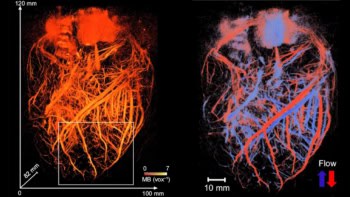
Diagnosis of brain tumours and planning for surgery or radiation treatment is currently performed using MRI. Contrast-enhanced T1-weighted imaging can reveal disruptions in the blood–brain barrier, although some brain lesions don’t disrupt the BBB and are thus not detected. T2-weighted images, meanwhile, visualize disease well, but also highlight regions of oedema and treatment effect. Another option is PET imaging, but the commonly used 18F-FDG tracer exhibits high uptake in normal brain tissue and cannot detect low-grade gliomas.

Clearly, there’s a need for an alternative imaging approach. Originally investigated back in the 1970s, 80s and 90s, amino acid (AA) PET tracers provide a high tumour-to-background uptake ratio and offer a promising approach for imaging brain tumours. But these tracers are not approved by the US Food and Drug Administration (FDA) for imaging of gliomas.
Speaking at the recent AAPM Annual Meeting in San Antonio, Deanna Pafundi from the Mayo Clinic explained how such tracers could enable functional-image-guided intracranial radiotherapy, and argued the case for their clinical adoption.
Seeing more
So how do AA tracers work? Pafundi explained that the rate of intracellular amino acid metabolism is greater in higher-grade tumours, and thus the level of tracer uptake correlates with disease. Notably, AA PET is also independent of BBB permeability.
The most commonly studied AA tracer is 11C-methionine, but its production requires an on-site cyclotron. 18F-based tracers, such as 18F-FET, 18F-DOPA and 18F-choline, however, can be shipped and may provide a more practical option. Pafundi pointed out that the last 10 years have seen a surge in publications covering “PET brain radiotherapy” and that the Mayo Clinic Enterprise has run several clinical trials with 18F-DOPA PET, with three still currently enrolling patients.
One key application for AA PET is in the initial biopsy/resection stage of treatment, where it can help target the most represented stage of disease for biopsy-only surgeries, and help define the extent of tumour resection. For example, in a patient with a non-enhancing lesion, it is difficult for the surgeon to select the most appropriate region to biopsy or resect. They may end up sampling a region of low-grade disease, while other areas actually contain high-grade tumours.
Using 18F-DOPA, Pafundi and colleagues found that a tumour-to-normal tissue (T:N) ratio threshold of 2.1 can differentiate high- from low-grade disease. She described an example case in which the preliminary MRI-based diagnosis was of a low-grade tumour. Subsequent 18F-DOPA PET imaging using this T:N ratio suggested high-grade disease. The final pathology turned out to be a grade IV astrocytoma.
Pafundi cited another case, a recurring tumour, in which use of the T:N ratio revealed a large area of high-grade disease that did not appear in the contrast-enhanced MRI. “AA tracers are very beneficial for recurring cases where T1 contrast imaging has limitations in detection capability,” she said. In this instance, the final diagnosis was grade IV astrocytoma.
Radiotherapy planning
Following diagnosis, the next step is to identify the extent of the lesion to be treated, using radiation therapy, for example. Pafundi noted that most recurrent brain tumours appear in or near to the primary treatment field, and postulated that this may arise from not treating all of the disease, as it is not all visible on the MR image. To address this shortfall, AA tracers can identify areas to treat in non-contrast enhancing lesions. And for contrast enhancing lesions, AA PET can increase the accuracy of tumour delineation.
Pafundi cited an example in which 11C-methionine PET revealed tumour tissue extending 3 cm outside of the contrast-enhanced MR image. Similar findings have been reported using 18F-FET PET, along with the Mayo Clinic studies using 18F-DOPA PET. As such, the addition of AA PET would have led to an increased treatment volume and possibly enhanced tumour control. Results from one of the Mayo Clinic trials showed that 18F-DOPA PET identified aggressive disease outside the MR image in over two-thirds of patients.
These findings suggest that contrast-enhanced MRI is not sufficient to identify areas of high-grade residual tumour, Pafundi told the audience. “These AA PET tracers all show disease that is not shown on conventional MRI and which should be taken into account during radiotherapy planning,” she explained. “Combining all of the available imaging modalities together would give a better idea of what we should be treating.”
For treatment planning, AA PET can help define the isodose volumes to irradiate, and in some cases could reduce the size of the irradiated region. In patients with non-contrast enhancing tumours, for example, typically the entire contoured T2-FLAIR volume is treated at 60 Gy. But not all T2 FLAIR is disease. Pafundi cited a study in which limiting the 60 Gy volume to areas of highly aggressive disease, as determined by 18F-DOPA PET, substantially reduced the volume irradiated at this dose.

Conversely, in some contrast enhancing lesions, including 18F-DOPA PET led to an increase in 60 Gy volume, as the AA tracer visualized disease outside of the MRI-defined region. Pafundi noted that, importantly, no extra toxicity was seen due to this dose escalation.
Finally, Pafundi presented a number of studies demonstrating how AA tracers can provide information on a patient’s post-treatment response, particularly in differentiating progression from pseudo-progression. “A lot of AA tracers are really going to be beneficial to help identify progression earlier,” she told the delegates.
“Over and over we’re showing that AA PET tracers provide valuable information for treating intracranial tumours,” she concluded. “Unfortunately, none are yet FDA approved for brain tumour imaging. I think it’s time we push to get these AA tracers FDA approved for the purpose of brain tumour imaging, and start looking to use these in the clinic.”



